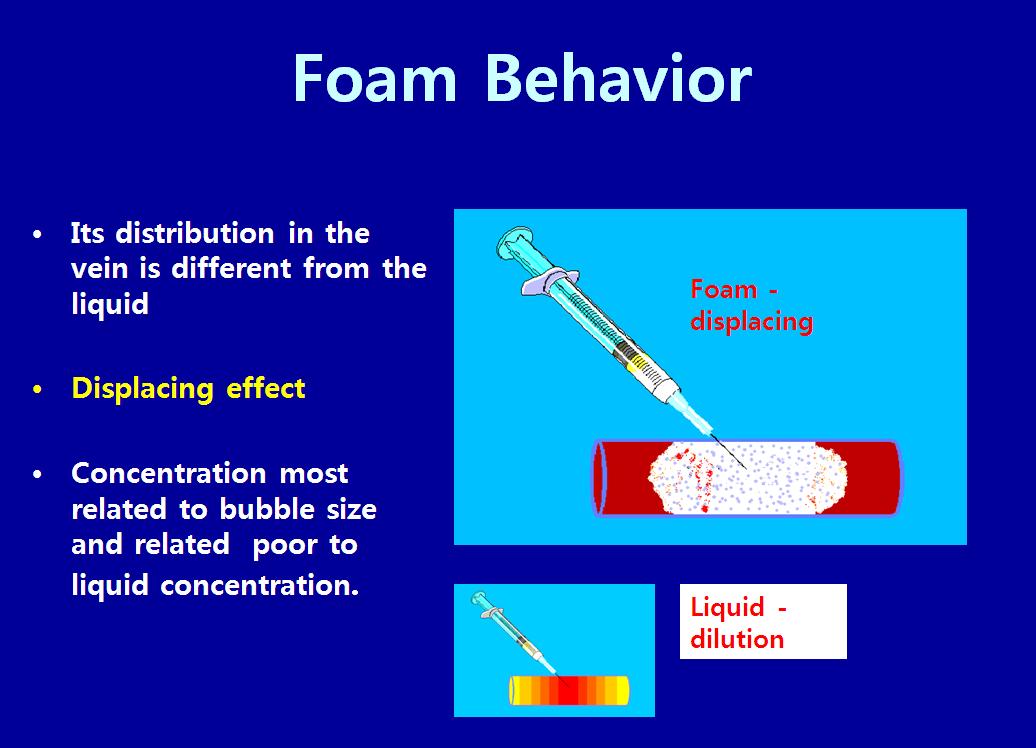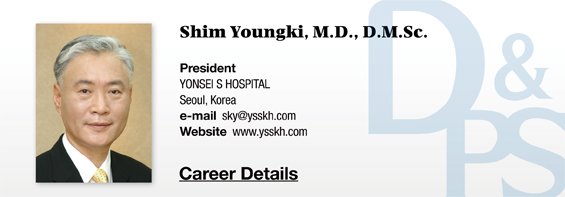▶ Previous Artlcle : #7-3. Conservative Therapy
FOAM sclerotherapy
Unlike the traditional method of injecting the liquid sclerosing agent in different concentrations depending on the vessel thickness, the recent method involves injecting a foam type sclerosing agent referred to as sclerosing FOAM or sclero-mousse.
History of foam
In 1944, Orbach introduced the AIR BLOCK technique. In this method, a small amount of air is injected into the veins prior to injecting the sclerosing agent. This method failed to be widely used as it created excessively large foam bubbles and the effect was minimal. In 1993, a Spanish doctor J.R.Cabrera Garrido proposed that a micro foam technique was effective in severe arteriovenous aneurysm. Garrido uses a special method to create foam and tries to commercialize the foam by getting his technique patented (CO2 + Lauromacrogol 400 + stabilizer: produced by David Wright Provensis, Co.Ltd.).
[Advertisement] FCR® (Fractional Prickle CoralCalcium Regentron) – Manufacturer: (www.illglobal.com)]
In 1995, A. Monfreux developed a foam creation technique using a glass syringe and in 1998 Benigni & Sadoun proposed a method of agitating the foam sclerosing agent using piston movement of a disposable plastic syringe. In 1999, Mingo Garcia proposed a foam production method using a special pressurized container. In 2000, Tessari connected two syringes to a 3 way tap and alternately operated the two syringes to produce micro foam. Tessari’s 3 way tap is currently the most widely used technique of foam scherotherapy.
Amount of air intravenously injected
H. N. Harkins and P. Harman reported that injecting 480ml of air within 20-30 seconds into a human adult weighing 60kg causes death. In their animal study with dogs, injecting 8ml/kg within 20-30 seconds led to death of animals. The cause of death was dyspnea due to large air bubbles being lodged in the respiratory system. In clinical practice, injection of a certain amount of air causes no harm to the human body. However, during foam sclerotherapy, caution should be given as air causes sclerosis. A. Frulini, A. Cavezzi, and L. Tessari et al. reported at International Union of Phlebology that 3ml of liquid solution is a safe amount to be injected per session. Cabrella reported that he injected at least 50ml of foam in a patient with severe congenital arteriovenous aneurysm. I have set the maximum amount to be 10ml od foam per injection since 2000 but actually inject 8ml of foam or less in most cases.
Sclerosing Foam Production Method
The ratio of Detergent solution to gas or air is 1:4
Fibrovein: air = 2ml : 8 ml

Tessari method

Foam Behavior
The pharmacological action of intravenously injected foam differs from that of liquid. Upon injection, liquid is immediately diluted by blood, whereas, foam fills up the blood vessels causing displacing effect while maintaining the drug concentration. The efficacy is actually determined by the bubble size rather than the concentration.
Small bubbles decrease the concentration of the air and increases the concentration of the drug. On the other hand, the air concentration is low and the drug concentration is high with large bubbles.
The sclerosing agent on the bubble surface maintains pure concentration and comes in full contact with the endothelial cells. Using this mechanism, 0.5% foam can treat large varicose veins over 10mm thick.
Foam Properties
Adhesiveness. Compact.
Long lasting. High echogenic.
Enhancing sclerosis. Reduction of conc. and amount of sclerosing agent.
Foam Sclerotherapy
has following benefits. Bloodless endovenous space.
Inert capillary venous tension. Prolonged endothelial contact: 5 min. stay in vessel.
Higher sclerosing effect. Reduce volume of using sclerosant.
Hyperechoic shadow during injection: possible to monitor by ultrasono. Methods of injection include using a needle, scalp needle and catheter, etc.
Fibrovein study
A total of 170 patients with the mean age of 55 and a mean diameter of great saphenous vein of 7mm were examined. The Fibrovein concentration used was 1.68%, and the liquid dose was 2.76ml.
The mixture ratio was 1:4~5 = Fibrovein : air.
Fibrovein study immediate results on 60 tx.
Good results……………… 93.3%
partial results……………… 5%
Good results……………… 1.6%
Complications:
Varicophlebitis……………… 3
Sclerosis propagation……… 1
-To be continued-





















